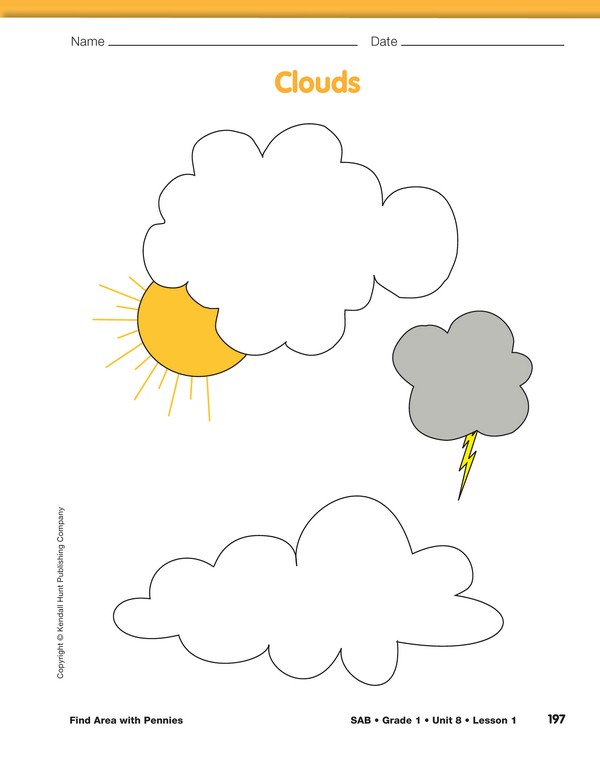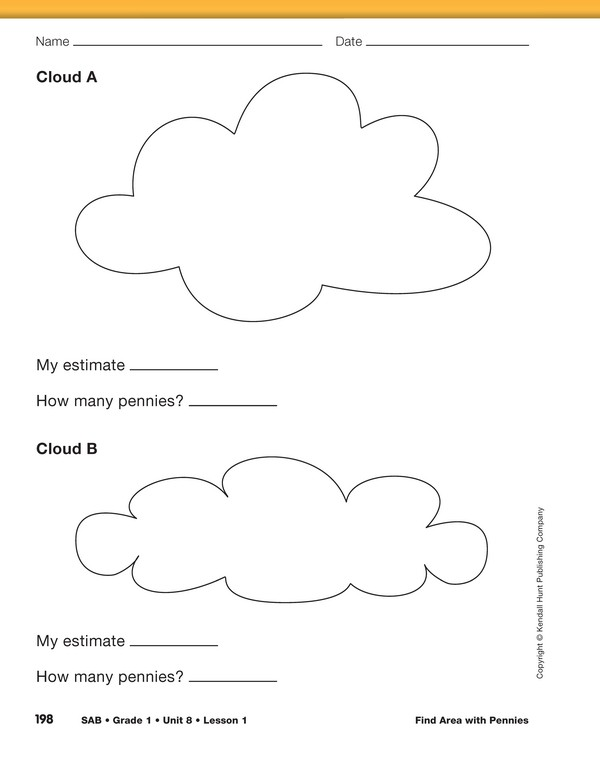Identify Properties to Measure. Display the first
Clouds page from the Student Activity Book and begin a discussion about the two white clouds.
Pose the following questions to the class:
- Which cloud looks larger to you?
- Why did you pick that one?
Some students may interpret “larger” to mean “taller”
while others may think “wider.” Point out to students
that larger can have several different meanings. A
third way to compare the size of two shapes is to see
which one covers more space. Ask for suggestions on
how to find which cloud covers more. Have students
look at the Clouds page.
- Which cloud is tallest?
- Which cloud is widest?
- Which covers the most space?
Students should be able to answer the first two questions
just by looking at the pictures. The third question
is trickier. Some students may suggest comparing
how much space the clouds cover by placing one on
top of the other. Demonstrate this approach using the
three cutout clouds and placing one on top of the
other. See Materials Preparation. The thunder cloud is
clearly smallest, since it actually fits inside each of
the other clouds. The two larger clouds can cover up
the thunder cloud. It is difficult, however, to compare
the two larger clouds since neither one fits on top of
the other. Using this method, it is difficult to tell
which cloud is larger.
Measure Area with Pennies. Encourage students to
think of another way to find out which cloud is larger.
Based on their experiences with measurement, some
students may suggest covering the clouds with some
unit. Suggest using a penny as a unit of measurement.
Pennies have one desired property of a measurement
unit—a uniform size and shape. Guide students to the
idea of covering the clouds with pennies and counting
how many fit inside each one. Students also may use
pennies to compare how tall and wide the clouds are,
but keep the activity focused on comparing the
amount of space in each cloud.
Have students estimate the areas of the clouds by
covering them with pennies. The cloud with the sun
has an area of about 16 pennies. The thunder cloud
has an area of about four pennies. The third cloud has
an area of about 14 pennies.
Area. At this grade level, students will describe area in
many different ways. It can be:
- how much the shape covers
- the amount of space covered by the shape
- the amount we need to cover the shape
- the area covered by the shape
One cannot expect a precise definition of area from
first-graders. Rather, we focus on helping students develop a
conceptual understanding of area.
When students find how many pennies fit in each
whole cloud, explain that they have found an estimate
of each cloud's area. Explain that the area is the
entire space inside the cloud. The students have estimated
the area by covering the cloud with identical
objects (pennies.)
Return to the initial conversation about which cloud is larger and ask the question again:
- Which cloud did we find is larger by measuring the area with pennies? (The cloud with the sun. It was
covered with 16 pennies and the others with four and 14 pennies.)
- Did the pennies cover the entire cloud? (no)
- How much is not covered? (Responses will vary.)
- How can you include the space not covered in your measurement?
(The area of the cloud is about 16–18 pennies.)
Estimate Quantities with Benchmarks. At this
point, spend a moment discussing what the word
estimate means. Write the word on the board.
- Have you ever made an estimate? What did you do? (Possible response: In Kindergarten, we guessed the number of things in a jar. The teacher
showed us a jar with ten things, then we used that to say about how many there were in another jar.)
- Did you have to find the exact number to have a good estimate? (No, we just had to say a number that was close. Sometimes we said between 10 and 20.)
From such a discussion, point out that when we estimate, we use what we know to make a smart guess about the number of objects or the size of something.
Estimation. Students have previously encountered estimation in
the context of predicting the number of given objects. Students
have also predicted whether an answer to an addition problem
is reasonable or not. In this lesson, students are introduced to
estimating measurement. This type of estimation assumes a
familiarity with the measuring unit and an ability to compare the
item to be measured with another item whose measurement is
already known. That is, it depends on being able to relate prior
experiences to the object to be measured.
Explain to students that one way to use what we
know to make a smart guess is to use benchmarks,
such as 5 or ten, with which they are familiar. To
facilitate using benchmarks, place 5 (or 10) pennies,
beans, cubes or some small counters on a display and
ask students to count them. Then place a larger number
of the same object on the display in an arrangement
that will make it hard for the students to count
the objects exactly. Tell students to use the 5 (or 10)
pennies as a benchmark and use them to make a good
guess of the number of objects on the display. Hide
the display. Write the numbers they guess under a display
of the word estimate and explain to the students
that their guesses are estimates.
- How did you decide what number you would guess? (Possible response: I looked and guessed from looking at the five pennies you showed us first.)
- Did you count the pennies? (Possible response: No. It was too hard to count them all.)
- Is your number the exact number on the display? (Possible response: Maybe, but probably not.)
Count out the exact number and compare it to the
numbers the students guessed. Explain to the students
the difference between guessing (estimating)
and finding the actual number. Also mention that
there are good guesses and bad guesses, good estimates
and bad estimates. Give some examples of
good guesses and bad guesses in the context of your
demonstration with the pennies. For example, if you
placed 20 pennies on the display, a good guess
would be somewhere between 15 and 25. A bad
guess could be 3, since it is clearly less than the
benchmark number 5 (or 10). Another bad guess
would be 100, since that would be an unreasonably
large guess.
Practice using 5 (or 10) as a benchmark for estimating
quantities by repeating the activity once or twice.
Guide students in estimating the quantity first then
counting to find the exact number. Discuss which
estimates students think were good or bad and their
reasons for their responses.
Estimate the Area with Pennies.
Have students look at Clouds A and B on the second Clouds page.
Before they measure the area using the pennies, ask them to think about the benchmark of 5 (or 10) pennies
to estimate how many pennies they think will be needed to cover each cloud. Have them write their guesses on the spaces provided for each.
- How did you decide which number to choose for your good guess? (Possible response: I thought of the 10 pennies and it looked twice as big so I
guessed 20 pennies. Cloud B looked like half of Cloud A with a little more so I guessed 11 pennies.)
- Did your work measuring the first page of clouds help you? How? (Possible response: Cloud A looks a little bigger than the 16-penny one we
did together so I added a few more and said 21 pennies.)
Then have the students find the area of each of the
two clouds using the penny measure and write their
measurement on the line provided for each. Tell
students to compare their measurement with their
estimates.
Observe students as they complete the Clouds page in the
Student Activity Book to assess their ability to estimate area by covering shapes with nonstandard units [E6].
To provide targeted practice with measuring area with
nonstandard units, place pennies and drawing paper in a
center and ask students to make and trace a shape made with
pennies and to count to find the area.
When students finish the Clouds page, have them
share their results. Conduct a discussion of the
activity as a whole. Focus on identifying strategies
for making an estimate (a good guess) and on the
difficulty of using the penny as a unit to measure
area. See the Sample Dialog.

This Sample Dialog focuses on helping students identify
strategies for making good estimates and the difficulties
of using a penny as a unit to measure the area of the cloud
pictures.
Teacher: Shannon, how did your answer for Cloud A compare to your estimate, your good guess?
Shannon: Not very good. I guessed 17 pennies and then when I put the pennies on, it was 19. So I was wrong.
Teacher: That's not being wrong, Shannon. Remember, an
estimate is a good guess that you make to understand
if your exact answer is reasonable or when you cannot
possibly count everything. Tell me how you decided on
17 pennies for your guess.
Shannon: Well, I looked at it and then I looked at the biggest
cloud on our first page. They were kind of alike except it
seemed like the new cloud was maybe a little bit bigger.
It seemed like it was fatter. So I made my guess a little
bit bigger.
Teacher: Shannon, I think that was a very good strategy for making your estimate. I think it was good reasoning.
Romesh: That's what I did, too. I looked at all the clouds. But I guessed 18 pennies because it just looked bigger to me.
Teacher: Good, those were both good guesses. Can someone give me an example of a guess that would be a bad guess?
Tanya: Two pennies.
Teacher: Tanya, why do you say two pennies would be a bad guess for Cloud A?
Tanya: Because Cloud A is really close to the sun cloud, but it's a little bigger. But two pennies is not bigger. It's a lot smaller.
Teacher: Good explanation, Tanya. If Cloud A is a little
bigger than the sun cloud, then it should take a few more pennies. What do you think about our strategy of
using pennies to figure out the area of the cloud, to figure out how much space is inside a cloud? Is it a good strategy?
Frank: I think it's good. I like using pennies. It's money.
Lee Yah: It was hard because the pennies kept pushing other pennies out. They didn't fit together.
Jacob: I had the same thing. My pennies didn't cover the cloud and when I tried to make them, then other pennies got pushed out.
Grace: Me, too. I don't think pennies are good because there's lots of the cloud that doesn't get covered.
Teacher: Those are all good points. Maybe pennies aren't the best way to measure area because they are round and leave space in between.
In the next lesson, we'll measure area in a way that doesn't leave spaces. That way, we'll be able to get a better measurement.

















